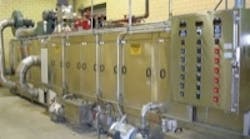Many companies currently using one-way transport packaging products such as intermediate bulk containers (IBCs) could benefit from container pooling, says Mike Brunhuber, v.p., A.R. Arena Products (Rochester, N.Y., www.arenaproducts.com). His company designs, manufactures and markets reusable structural plastic products. It also started the first reusable plastic container pooling business in the United States in 1993.
"Many of our customers," says Brunhuber, "are converting to reusable containers for reasons slightly different from even five years ago. Environmental issues are now a priority."
He says that in the past people talked about the environmental benefits of using returnable containers, however, in the end it was always about money. Now, the money issues and environmental issues make equal sense.
"Two things the potential user of returnables has to get his arms around," says Brunhuber, "are the actual, not hoped for, return rate of containers; and the attrition rate of containers."
Determining the return rate, or how fast a container gets back to be used again, can be tricky. Companies currently using one-way packaging might not have all the facts and figures on which managers can base a decision. Brunhuber says the more complex the distribution network, the more containers a user will require to accommodate distributors, break-bulk terminals, warehousing and other places where a container will just sit.
Keeping track
A.R. Arena uses Web-based system to track containers. All of its containers carry bar code labels on four sides. Scanning is done at virtually every stop along the way.
"We follow a container from the time it leaves our depot and moves to the fill point, through its entire logistics channel and back to our depot," says Brunhuber. "We like to have at least four points along the way where we can scan."
Determining when to ship containers back to the depot can be a challenge for users. A.R. Arena bases its rates on the space the collapsed containers will occupy in a truck.
"We know that seven collapsed containers occupy a footprint of a single pallet, and that 21 containers is the minimum optimal return load," he explains. Using its Web-based system the company can determine when its customers should have accumulated those 21 containers. It then sends an e-mail notification to confirm the containers were used, and that the truck will be picking up the empties on a specific date.
Eric Fredrickson, consultant and reusable container specialist (Lancaster, Mass.), says there are two things that keep companies from converting to reusables: Not wanting to appropriate capital to a non-core business is at the top of the list. "And not having confidence that they'll be able to manage reusables, not lose them, not get them back in a timely manner, etc."
A container pooling company takes those issues off the table, says Fredrickson. It provides potential users with directly with single-use packaging.
Another barrier to implementing a reusable packaging program is that a company might be reluctant to launch its own reusable container program when the product is moving from one company to another. "Who makes the investment and who gets the savings? Using a third-party pooling service eliminates that problem," says Fredrickson.
Keeping things clean
Another issue that gives potential users of reusable containers pause is cleaning. Given the increasing requirements mandated by food and pharmaceutical regulations, cleaning containers becomes a big hassle. Cleaning, however is another issue that a thirdparty resolves easily. It often makes more sense to outsource cleaning as part of a bundled service versus trying to implement it in house.
"Our depots have specifications for all container cleaning," Brunhuber says. "It's not like having a car wash that you can drive any size container through. There's no generic machine for cleaning. Washing and drying are specific to the configuration of the container."
Another part of the cleaning problem is having adequate space within a distribution center to do the work, then store the cleaned units.
Using a third-party container pooling service, even for companies that have already converted to reusable containers, is a way to get a clearer picture of transport packaging costs. It eliminates the hidden costs because rates are fixed with a pooling service.
Arena-Alas automated washer cleans reusable containers.



